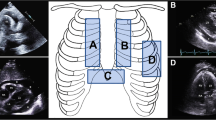Abstract
Purpose
This study was designed to evaluate the safety and efficacy of CT-guided drainage of the pericardial effusion in patients after cardiac surgery.
Materials and Methods
The study included 128 consecutive patients (82 males, 46 females; mean age 66.6 years, SD: 4.2) complicated by pericardial effusion or hemopericardium after cardiac surgeries between June 2008 and June 2016. The medical indication for therapeutic pericardiocentesis in all patients was hemodynamic instability caused by pericardial effusion. The treatment criteria for intervention were evidence of pericardial tamponade with ejection fraction (EF) <50%. The preintervention ejection fraction was determined echocardiographically with value between 30 and 40%. Exclusion criteria for drainage were hemodynamically unstable patients or impaired coagulation profile (INR <1.8 or platelet count <75,000). Drains (8F–10F) were applied using Seldinger’s technique under CT guidance.
Results
Pericardiocentesis and placement of a percutaneous pericardial drain was technically successful in all patients. The mean volume of evacuated pericardial effusion was 260 ml (range 80–900 ml; standard deviation [SD]: ±70). Directly after pericardiocentesis, there was a significant improvement of the ejection fraction to 40–55% (mean: 45%; SD: ±5; p < 0.05). The mean percentage increase of the EF following pericardial effusion drainage was 10%. The drainage was applied anteriorly (preventricular) in 39 of 128 (30.5%), retroventricularly in 33 of 128 (25.8%), and infracardiac in 56 of 128 (43.8%). Recurrence rate of pericardial effusion after removal of drains was 4.7% (67/128). Complete drainage was achieved in retroventricular and infracardiac positioning of the catheter (p < 0.05) in comparison to the preventricular position of the catheter. Recorded complications included minimal asymptomatic pneumothorax and pneumomediastinum 2.3% (3/128) and sinus tachycardia 3.9% (5/128).
Conclusion
CT-guided drainage of postoperative pericardial effusion is a minimally invasive technique for the release of the tamponade effect of the effusion and improvement of cardiac output.


Similar content being viewed by others
References
Kim HJ, Jung SH, Kim JJ, et al. Early postoperative complications after heart transplantation in adult recipients: asan medical center experience. Korean J Thorac Cardiovasc Surg. 2013;46:426–32.
Ashikhmina EA, Schaff HV, Sinak LJ, et al. Pericardial effusion after cardiac surgery: risk factors, patient profiles, and contemporary management. Ann Thorac Surg. 2010;89:112–8.
Saltzman AJ, Paz YE, Rene AG, Green P, Hassanin A, Argenziano MG, et al. Comparison of surgical pericardial drainage with percutaneous catheter drainage for pericardial effusion. J Invasive Cardiol. 2012;24:590–3.
Bogaert J, Francone M. Pericardial disease: value of CT and MR imaging. Radiology. 2013;267:340–56.
Wang ZJ, Reddy GP, Gotway MB, et al. CT and MR imaging of pericardial disease. RadioGraphics. 2003;23:167–80.
Eichler K, Zangos S, Thalhammer A, et al. CT-guided pericardiocenteses: clinical profile, practice patterns and clinical outcome. Eur J Radiol. 2010;75:28–31.
Imazio M, Adler Y. Management of pericardial effusion. Eur Heart J. 2013;34(16):1186–97.
Imazio M. Contemporary management of pericardial diseases. Curr Opin Cardiol. 2012;27(3):308–17.
Ristić AD, Imazio M, Adler Y, et al. Triage strategy for urgent management of cardiac tamponade: a position statement of the European Society of Cardiology Working Group on Myocardial and Pericardial Diseases. Eur Heart J. 2014;35(34):2279–84.
Maggiolini S, Gentile G, Farina A, et al. Safety, efficacy, and complications of pericardiocentesis by real-time echo-monitored procedure. Am J Cardiol. 2016;117(8):1369–74.
Author information
Authors and Affiliations
Corresponding author
Ethics declarations
Conflict of interest
The authors state the fact that this article is not under consideration for publication elsewhere or any part of it has been sent elsewhere, and there is no conflict of interest. The Publication is approved by all authors. There are no conflicts of interest. We also agree the regulations of copyright of the publisher.
Rights and permissions
About this article
Cite this article
Nour-Eldin, NE.A., Alsubhi, M., Gruber-Rouh, T. et al. CT-Guided Drainage of Pericardial Effusion after Open Cardiac Surgery. Cardiovasc Intervent Radiol 40, 1223–1228 (2017). https://doi.org/10.1007/s00270-017-1624-2
Received:
Accepted:
Published:
Issue Date:
DOI: https://doi.org/10.1007/s00270-017-1624-2




